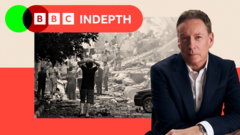This initiative is a response to years of military decline, as Canada seeks to meet NATO obligations while reducing dependence on the U.S.
Canada Plans Major Military Revamp Amidst Rising Global Tensions

Canada Plans Major Military Revamp Amidst Rising Global Tensions
Prime Minister Carney aims to increase defense spending significantly to strengthen Canada's military capabilities.
As global geopolitical tensions rise, Canada is making a bold move to revitalize its military capabilities. Prime Minister Mark Carney announced plans to inject billions into the defense budget, aiming to meet NATO’s spending targets within an unprecedented timeline. This strategy not only responds to ongoing criticisms, particularly from former President Trump regarding Canada’s defense dependency on the U.S., but also aims to fortify Canada’s military stance in a changing world order.
Historically, Canada had a formidable military presence, especially post-World War II, with one of the largest navies globally. However, the current state of the Canadian armed forces tells a different story. Recent figures reveal just about 11,500 members in the Royal Canadian Navy, down from its peak during the war, and only 40 operational vessels compared to hundreds earlier. Adding to the concern, the Canadian military is currently understaffed, missing over 16,000 personnel from the authorized limit of 101,500, including reservists.
To expedite Canada's military enhancement and ensure it aligns with NATO commitments, which have recently sparked debates with allies amid Trump’s isolationist policies, Carney has designated an additional 9.3 billion Canadian dollars (approximately $6.8 billion) for defense. However, questions loom regarding the sources of this funding and the capability of the military to efficiently allocate and utilize these resources within the outlined timeframe.
The proposed military upgrade reflects a broader trend among Western allies—including Britain and Germany—who are similarly bolstering their defense capabilities in response to perceived global threats. As Canada looks to break away from an over-reliance on its neighbor and augment its sovereignty, the outcome of this initiative remains to be seen amidst scrutiny and logistical challenges.
Historically, Canada had a formidable military presence, especially post-World War II, with one of the largest navies globally. However, the current state of the Canadian armed forces tells a different story. Recent figures reveal just about 11,500 members in the Royal Canadian Navy, down from its peak during the war, and only 40 operational vessels compared to hundreds earlier. Adding to the concern, the Canadian military is currently understaffed, missing over 16,000 personnel from the authorized limit of 101,500, including reservists.
To expedite Canada's military enhancement and ensure it aligns with NATO commitments, which have recently sparked debates with allies amid Trump’s isolationist policies, Carney has designated an additional 9.3 billion Canadian dollars (approximately $6.8 billion) for defense. However, questions loom regarding the sources of this funding and the capability of the military to efficiently allocate and utilize these resources within the outlined timeframe.
The proposed military upgrade reflects a broader trend among Western allies—including Britain and Germany—who are similarly bolstering their defense capabilities in response to perceived global threats. As Canada looks to break away from an over-reliance on its neighbor and augment its sovereignty, the outcome of this initiative remains to be seen amidst scrutiny and logistical challenges.





















